Term 3 Chapter 4 | 7th Maths - Geometry | 7th Maths : Term 3 Unit 4 : Geometry
Chapter: 7th Maths : Term 3 Unit 4 : Geometry
Geometry
Chapter 4
GEOMETRY

Learning Objectives
● To recall the types of symmetry through
diagrams.
● To learn symmetry through transformation
(Translation, reflection and rotation).
● To construct circles and concentric
circles.
Recap
In class VI we have learnt the concept
of symmetry. Now we shall recall them.
Line of Symmetry
Look at the Fig. 4.1 given on
the right.

In each figure a line divides the figure
into two identical halves. Such figures are symmetrical about the line. The line
that divides any figure into two equal halves such that each half exactly coincides
with the other is known as the line of symmetry or axis of symmetry.

A figure may have one, two, three or more lines of symmetry. Some figures which has lines of symmetry are shown in Fig. 4.2 .
Try these
1. Can you draw a shape which has no line of symmetry?
Solution: Yes,

2. Draw all possible lines of symmetry for the following shapes.

Solution:
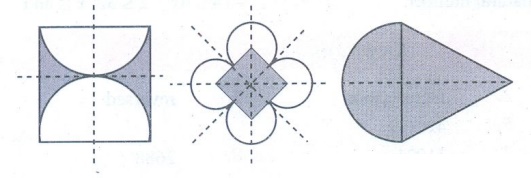
Think
What can you say about
the number of lines of symmetry of a circle?
Solution: A circle has infinite number of lines of
symmetry.
Reflectional symmetry
When an object is seen in a mirror, the
image obtained on the other side of the mirror is called its reflection.
An object and its mirror image are perfectly
identical to each other. The left and right sides of an object appear inverted in
the mirror. The object and its reflection image show mirror symmetry. The mirror
line here is the line of symmetry. Mirror symmetry is called reflectional symmetry.
The following shapes are examples of
reflectional symmetry.

The reflected shape will be exactly the
same as the original, the same distance from the mirror line and the same size.
While dealing with mirror reflection, care is needed to note down the left-right
changes in the orientation.
Try these
1. Reflect the words CHEEK, BIKE, BOX with horizontal line.
Solution:

2. Reflect the following words with vertical line.
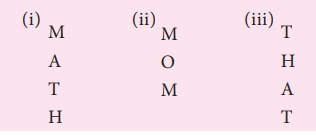
Solution:
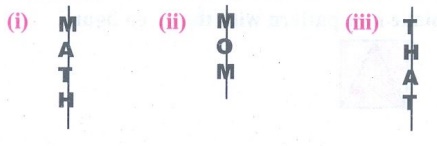
Think
Will the figure be symmetric
about both the diagonals?
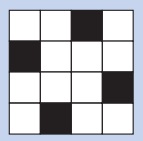
Solution: Yes, it is symmetric about both the diagonals.
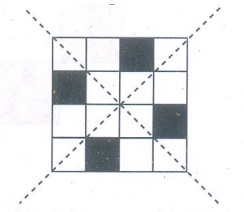
Do you Know
The work of artist Leonardo
da Vinci has an unusual characteristic. His hand writing is a mirror image of normal
handwriting.
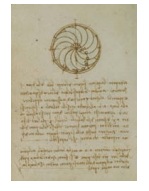
Rotational Symmetry
An object is said to have a rotational symmetry if it looks the same after
being rotated about its centre through an angle less than 360°.
When an object rotates around a fixed
axis if its appearance of size and shape does not change then the object is supposed
to be rotationally symmetrical.
Rotational symmetry can be observed in
the following Fig. 4.4
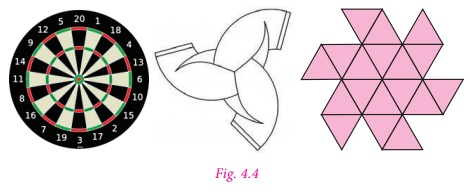
The minimum angle of rotation of a figure
to get exactly the same figure as original is called the angle of rotation.
The total number of times a figure coincides
with itself in one complete rotation is called the order of rotational symmetry.
We can only rotate the figure up to 360 degrees.

It is important to understand that all
figures have rotational symmetry of order 1, as can be rotated completely through
360º to come back to its original position. So we say that an object has rotational
symmetry, only when the order of symmetry is more than 1. So, 2 is the smallest
order of rotational symmetry.
Try these
1. Find the order of rotational symmetry of the following figures.
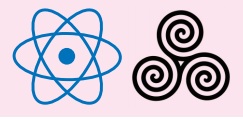
Solution:
(i) Order of symmetry : 6
(ii) Order of symmetry : 3
2. Find the order of rotational symmetry for an equilateral triangle.
Solution:
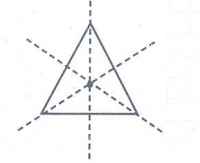
For an equilateral triangle
order of rotation symmetry is 3.
Think
Can a parallelogram have
a rotational symmetry?
Solution:

Yes, order of rotational symmetry is 2.
Translational Symmetry
An image has translational Symmetry if
it can be divided by straight lines into a sequence of identical figures. Translational
symmetry results from moving a figure to a certain distance in a certain direction.
Thus, translation
symmetry occurs when a pattern slides to a new position. The sliding
movement involves neither rotation nor reflection.
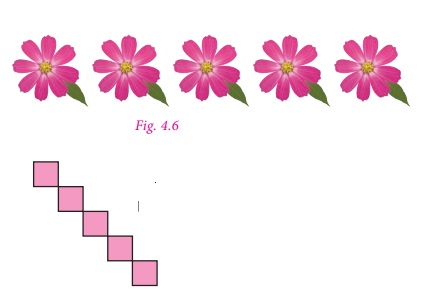
Try this
Using translational symmetry
make new patterns with the given figure.

Solution:
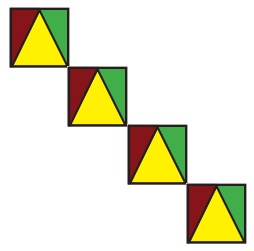
Introduction
Symmetry is a fundamental part of geometry,
nature, and shapes. It creates patterns that help us to recognize the beauty of
the nature. An object exhibits symmetry if it looks the same after a transformation,
such as reflection or rotation.
Symmetry is the underlying mathematical
principle behind all patterns. Symmetry plays a significant role in the field of
Arts, Sciecne and architecture. We learnt the concept of symmetry in class VI.
Now we are going to learn symmetry through
transformations. Transformations describe how geometric figures of the same shape
are related to one another.
One of the most important applications
of mathematics in daily life is the concept of geometric transformation. Students
need to learn this concept so as to understand the nature and environment they live
in. Transformation concept is very important to learn since it helps students to
understand their situations in daily life.
This concept is a necessary mental tool
to be able to analyse mathematical situations. It enables students to make up rules
and patterns, make explorations, be more motivated to do better works and gain rich
experiences by doing maths.
Rotation, translation, reflection concepts
within geometrical transformations are used in daily life, architectural designs,
art and technology. Above all an aesthetic sense of beauty is observed in objects
due to symmetry. Let us see the three types of transformation namely translation,
reflection and rotation in this chapter.
MATHEMATICS ALIVE - Gemetry in Real Life
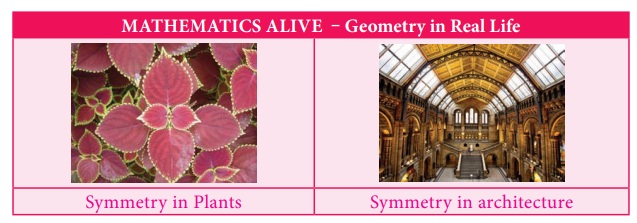
Related Topics